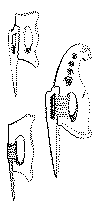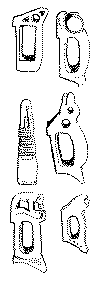By Robert De Groat

Native Paint Brush and 3 Knives
Primitive man's tools were rough, crude, sharpened pieces of wood, bone, flint, or metal. Perhaps his war club was his first combined weapon and tool. Through the ages tools have developed and improved to our present day fine tools made of steel and other rare tempered metals.

Adze Made of Old File and Bone Handle
Natives cut decorative wood patterns with knives. Today the knife is used as one of the important wood-carving tools. In addition, chisels, gouges, veiners and parting tools of various shapes, sizes and temper are also used. A careful thoughtful wood carver uses the fewest possible tools, and gets results with those few.

Chipping Board with Adze Made from Axe
Blade
The Most Useful Tools for Smaller Poles and Objects
| Scout knife well sharpened. | |
| Veiner or parting tool. | |
| Short bend or spoon gouge. | |
| Back bent gauge. | |
| Small hack saw. | |
| A work bench, bench hook and wooden vise. |

Results of Several Methods of Chipping
with Adze
The Most Useful Tools for Larger Poles and Objects
| Scout axe, well ground and sharpened. | |
| Two-man or buck saw, smaller saws. | |
| Large felling axe. | |
| Heavy 1 1/2 inch chisels, one flat, another half-round. | |
| Heavy gouges, at least two sizes. | |
| Adze. |
In carving larger poles it is sometimes handier to have the pole raised up on horses, thus bringing the work to a more convenient height.

Side and bottom views of
an adze show how quills
take up slack and add
spring to the contrivance.

Two carving knives used by
the Indians in making
totem poles,
and the sheathes that go with them.
At bottom is a chisel.
Adzes

Three hand Adzes.
Originally the handles of adzes were made from the bones of
whales. The cutting edges were hard bone, slate, or flint.
The North American natives quickly adopted and utilized the fine steel of the white man's axes and files, finding that with such tools they could work much more rapidly and produce better results.

Various types of adze handles, some of them bearing
decorative carvings.
Nowadays willow wood is used for the handles of adzes. A Scout can saw an axe in two pieces and have two adze blades. Or he can grind down a file.
The handle can be carved from willow wood and a thong used to bind the blade to the handle.
Quills of feather were inserted by the Indians to take up any slack.
Treatment of Tools
The wood carver must be able to sharpen, set and keep his tools in order. Remember that:
| Tools require grinding on grindstone. | |
| Whetting on oil stone or slips. | |
| Finally (for smaller tools) stropping on a leather strop. |

Demonstrating the Method of Holding the
Adze
Often tools are sold which are already ground. These need to be whetted and stropped.
If possible secure a grindstone provided with a pedal for foot power. Thus both hands will be free to hold the tool while grinding. Flat stones require more manipulation and are much harder to use.

How to Hold the Crooked Knife in Carving
The stone is revolved away from the person. The tools must be held to give long slope, at least a 60 degree slant. When the thickness of the cutting edge is ground down, it must be whetted by rubbing on an oil stone. The white line must not be visible when the eye looks down upon the cutting edge when it is held against the light. Both sides of most tools must be sharpened.

Back of Mask Showing Rough Chiseling and
Chipping
Straight-edged tools--chisels, skews--must be whetted on both sides and on an oil stone. Curved tools are sharpened on specially shaped stones, "slips," because inside and outside edges require sharpening. The V-shaped tool requires a wedge-shaped slip for sharpening.
When grinding chisels, skews, straight or oblique, hold them in the right hand, press upon the shank with the fingers of the left hand to secure a flat surface. Move tools across the stone right and left as stone revolves. Do not hold in one position as ruts are likely to be worn in tool. When the edge is sufficiently thin rub tool on oil stone which has been covered with thin coat of any good oil. When sufficiently whetted, strop to clean up edge. Strop may be made of a good piece of buffed leather, 8 inches by 2 inches. This is covered with paste of tallow or crocus powder. Hold strop straight and firm. Draw tool down evenly and quickly toward you. Repeat this until tool has fine edge.
When grinding gouges and flutes, you will find more difficulty in the sharpening process. Their convex side must be next to stone and a rolling movement kept up from side to side to attain even convexity over whole edge.

This diagram illustrates the Indians' method of
rolling a totem pole upright into a hole prepared as shown. The log underneath rolls down
the incline, helping to bring the totem upright.
For general purposes keep the edges level. After grinding these, they may be whetted on flat oil stone by rolling motion on the convex side. Tools with decided curvature are better whetted on flat side of "slip" held in left hand so that the cutting edge may be watched. For the inside of the tool a slip with plenty of oil and an edge to fit the curve is best. Be sure to hold slip at an angle with tool. Flat gouges are stropped by laying edge flatly on leather. Larger gouges may be rubbed on ridge of strop formed by rounding or squeezing up strop into a round form. To sharpen small V-shaped tools shape pieces of wood in strips to fit inside and cover with crocus paste.